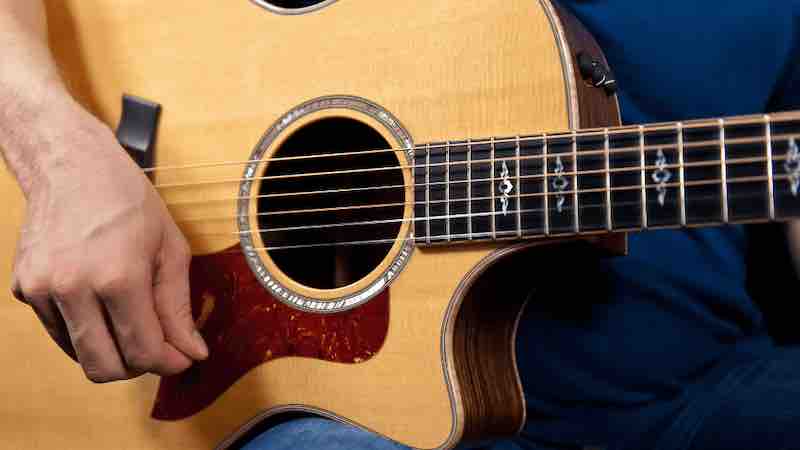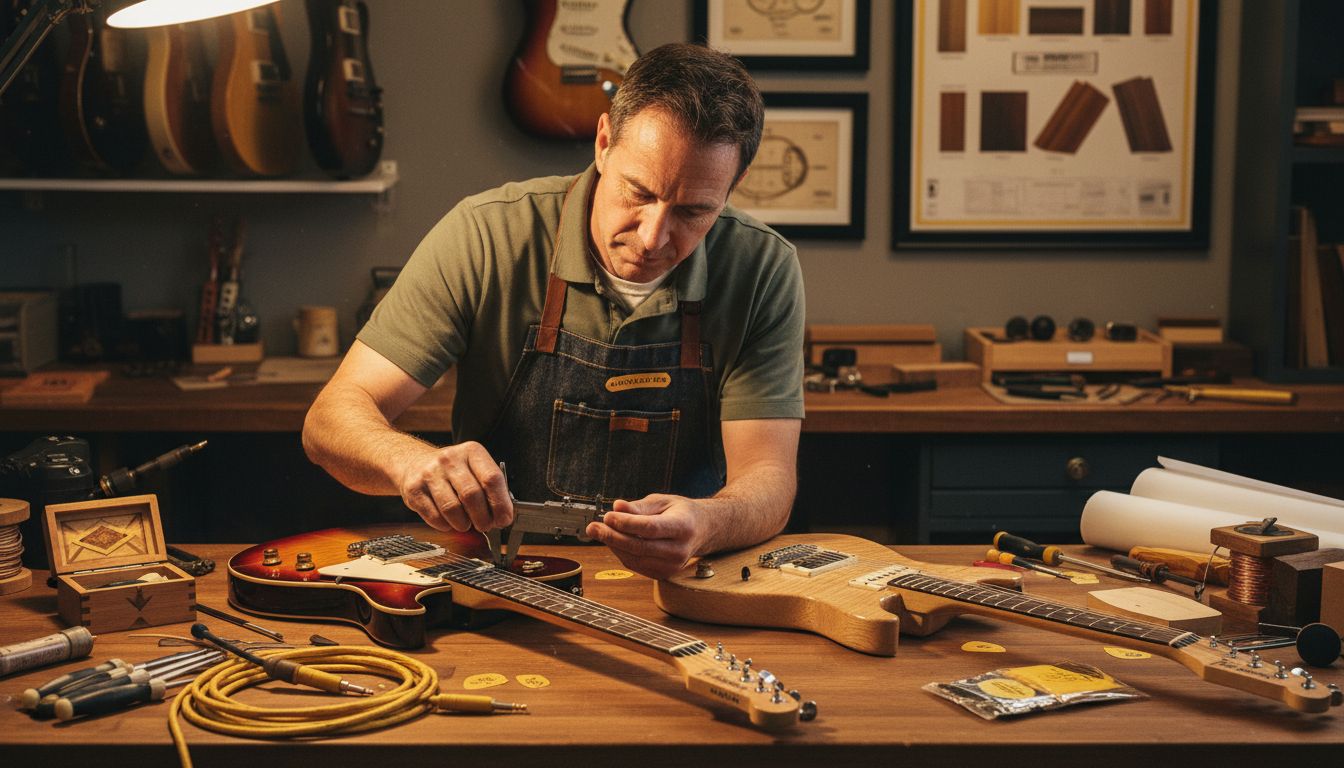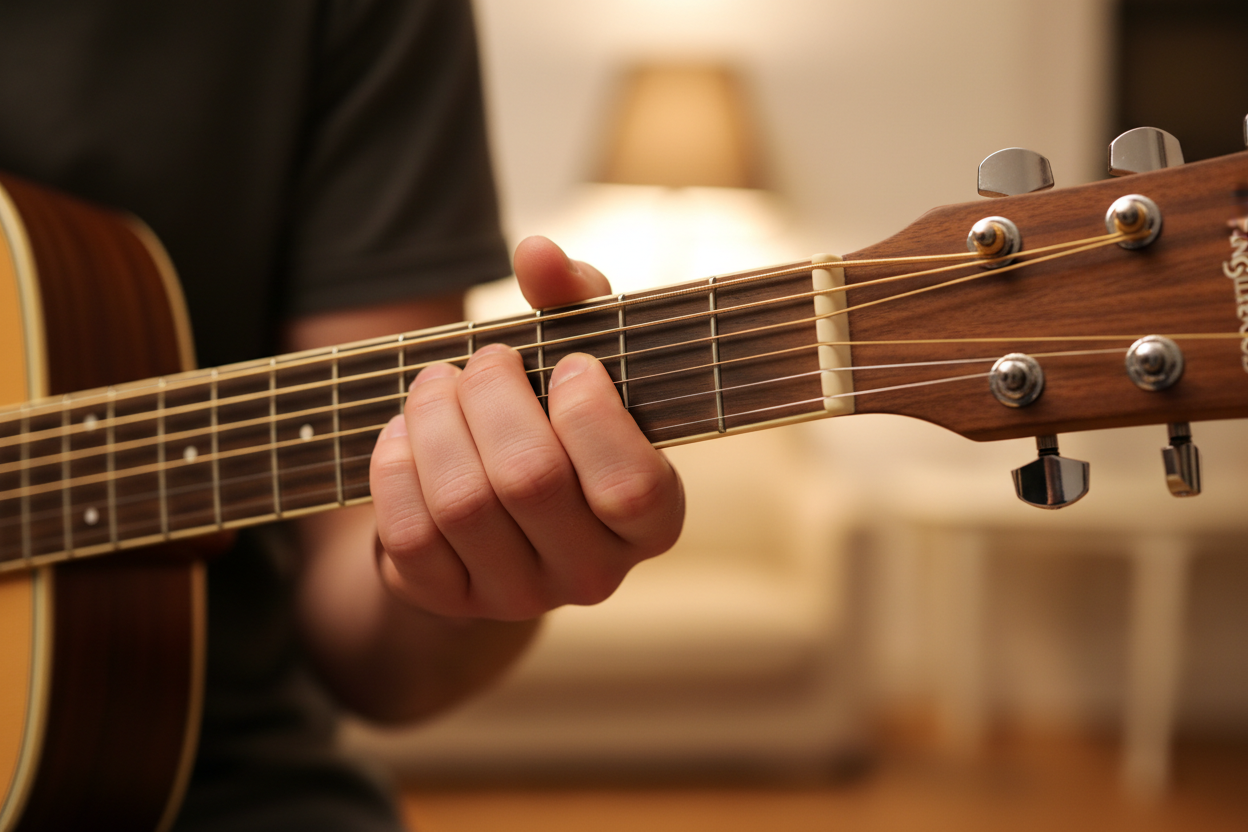Unleashing the magic of music begins with mastering the guitar, a journey that transforms passion into prowess. Whether you’re a complete novice hoping to strum your first chord or an aspiring virtuoso aiming to refine your skills, “Strumming Success: The Ultimate Guide to Mastering Your Guitar Skills” is made just for you. This comprehensive guide takes you through every essential step, from choosing the perfect instrument to understanding intricate techniques that bring your favourite songs to life. Packed with practical tips and insightful advice, you'll discover the secrets to building confidence and achieving consistent progress. Embrace the rhythm, tackle challenges head-on, and immerse yourself in the joy of playing.
Get ready to strum your way to success and turn dreams into reality one chord at a time! Whether your goal is to play for your friends, join a band, or simply enjoy the art of music, this guide will be your trusty companion on the path to guitar mastery.
Understanding the Basics of Guitar Playing
Mastering the guitar begins with understanding the basics, a foundation on which all great musicians build their skills. The first step is familiarising yourself with the parts of the guitar. Acoustic guitars, classic and electric guitars each have unique features, but they share common components like the body, neck, headstock, fretboard, strings, and tuning pegs. Knowing these parts and their functions will help you maintain your instrument and understand how it produces sound.
Once you are acquainted with the guitar's anatomy, the next step is learning how to hold it properly. Whether sitting or standing, maintaining a comfortable posture is crucial. For right-handed players, rest the guitar on your right thigh and use your right hand for strumming or picking, while your left hand presses down on the strings to form chords. Left-handed players can reverse this setup or use a left-handed guitar. Adjust the guitar strap to a length that allows the instrument to rest at a comfortable height, preventing strain on your back or shoulders.
Tuning your guitar is another essential skill for beginners. An out-of-tune guitar can make even the most skillful playing sound unpleasant. Invest in a quality tuner or use a tuning app to ensure each string is perfectly pitched. Standard tuning from the lowest to highest string is E-A-D-G-B-E, but various alternate tunings can be explored as you advance. Regularly tuning your guitar trains your ear and ensures you always sound your best.
Essential Guitar Techniques for Beginners
Once you have a grasp on the basics, it's time to dive into essential techniques that will form the core of your guitar playing. Chords are the building blocks of many songs, and learning a few basic chords like E major, A major, and D major will enable you to play countless tunes. Start by practicing these chords individually, ensuring each string rings clearly. Gradually, practice transitioning between chords smoothly and accurately.
Strumming is another fundamental skill. Begin with simple downstrokes, focusing on maintaining a steady rhythm. As you become more comfortable, incorporate upstrokes to create a fuller sound. Experiment with different strumming patterns to add variety to your playing. Use a metronome to help keep a consistent tempo, which is vital for developing solid rhythmic skills.
Picking is another technique that adds versatility to your repertoire. Start with alternate picking, where you alternate between downstrokes and upstrokes. Practice on individual strings before moving on to more complex patterns. Fingerpicking, where you use your fingers instead of a pick, opens up a world of possibilities for playing intricate melodies and arpeggios. Start with simple patterns and gradually increase the complexity as your finger strength and dexterity improve.
The Importance of Proper Posture and Hand Position
Achieving proper posture and hand position is essential for preventing injury and ensuring efficient playing. Good posture not only helps you play better but also allows you to practice for longer periods without discomfort. When sitting, choose a chair that provides good back support and keep both feet flat on the ground. Avoid slouching or leaning too far forward, as this can strain your back and shoulders.
Your left hand’s position on the fretboard is equally important. Keep your thumb behind the neck, roughly in the middle, to provide support. This allows your fingers to arch over the strings and press down accurately. Avoid letting your thumb wrap around the neck, as this limits your finger's reach and mobility. Keep your fingers close to the frets, but not directly on top of them, to minimize buzzing and ensure clear notes.
The right hand's position varies depending on whether you are using a pick or fingerpicking. When using a pick, hold it between your thumb and index finger, allowing a small portion to protrude for striking the strings. Rest your palm lightly on the bridge to stabilize your hand without muting the strings. For fingerpicking, rest your thumb on the lower strings and use your index, middle, and ring fingers to pluck the higher strings. Keeping your hand relaxed and your movements economical will improve your speed and accuracy.
Strumming Patterns: A Key to Rhythmic Mastery
Strumming patterns are crucial for developing a strong sense of rhythm and bringing your guitar playing to life. A good strumming pattern can transform a simple chord progression into a dynamic and engaging piece of music. Begin with basic patterns, such as the downstroke-only strum, to build a solid foundation. Focus on keeping a steady tempo and ensuring each strum is even and consistent.
As you progress, introduce more complex patterns that incorporate both downstrokes and upstrokes. For example, a common pattern is down-up-down-up, which creates a smooth and continuous sound. Practice this pattern slowly at first, gradually increasing the speed as you become more comfortable. Use a metronome to help maintain a consistent rhythm and prevent rushing or dragging the beat.
Experimenting with different strumming patterns can add variety to your playing and help you better express the mood of a song. Try patterns like the calypso strum (down, down-up, up, down-up) or the syncopated strum (down, up, down, up, down, up, down-up). Each pattern has its unique feel and can be used to enhance different styles of music. Listen to your favorite songs and try to replicate the strumming patterns you hear, which will improve your ear and rhythmic skills.
Developing Finger Strength and Dexterity
Developing finger strength and dexterity is essential for playing the guitar with precision and speed. Strong, agile fingers allow you to play complex chords, fast solos, and intricate fingerpicking patterns with ease. Start by incorporating finger exercises into your practice routine. Simple exercises like chromatic scales, where you play each fret on a string in sequence, can significantly improve your finger strength and coordination.
Another effective exercise is the spider walk, where you place your fingers on different frets and strings, moving them in a coordinated manner. This exercise challenges your finger independence and helps build muscle memory. Ensure you practice these exercises slowly at first, focusing on accuracy and control. Gradually increase the speed as you become more comfortable.
Using a grip strengthener or stress ball can also enhance your finger strength. Squeeze the device for a few minutes each day to build muscle in your fingers, hand, and forearm. Additionally, practicing barre chords, where you use one finger to press down multiple strings, is an excellent way to strengthen your fingers and improve your hand endurance. Guitar Strings play a crucial role here their gauge and material affect tension and resistance, which influences finger development. Remember to take breaks and stretch your hands to prevent strain and injury.
Learning to Read Guitar Tabs and Sheet Music
Reading guitar tabs and sheet music is a valuable skill that opens up a world of musical possibilities. Guitar tabs, or tablature, provide a simplified way to learn songs by showing which frets and strings to play. Tabs are widely available online and in guitar books, making it easy to find music for your favorite songs. Start by understanding the basics of tab notation, such as the lines representing strings and the numbers indicating frets.
Sheet music, on the other hand, provides a more comprehensive representation of music, including rhythm, dynamics, and articulation. Learning to read standard notation can be challenging but immensely rewarding. Begin with simple melodies and gradually work your way up to more complex pieces. Familiarize yourself with the notes on the staff, the timing of different note values, and the symbols for various dynamics and articulations.
Combining both tabs and sheet music in your practice can enhance your musical understanding and versatility. Use tabs to quickly learn new songs and sheet music to deepen your knowledge of music theory and improve your sight-reading skills. Many resources, such as guitar method books and online courses, offer step-by-step instructions for learning to read both tabs and sheet music. Dedicate time each week to practicing these skills, and you'll become a more well-rounded guitarist.
Tips for Practicing Effectively and Staying Motivated
Effective practice is key to mastering the guitar and achieving your musical goals. Start by setting specific, achievable goals for each practice session. Whether it's learning a new chord, perfecting a strumming pattern, or working on a challenging piece, having clear objectives will keep you focused and motivated. Break down complex tasks into smaller, manageable steps to avoid feeling overwhelmed.
Consistency is crucial for progress. Aim to practice every day, even if it's just for a few minutes. Short, focused practice sessions are often more effective than infrequent, lengthy ones. Create a practice schedule that fits your lifestyle and stick to it as much as possible. Use a practice journal to track your progress and identify areas that need improvement.
Staying motivated can be challenging, especially when you encounter difficulties or plateaus. Keep your practice sessions enjoyable by incorporating your favorite songs and exploring new genres. Join a guitar community, either online or in person, to share your progress and receive encouragement from fellow musicians. Set long-term goals, such as performing in front of an audience or recording your music, to keep yourself inspired and driven.
If your guitar feels uncomfortable or sounds off, it might be time for a setup or Guitar Repairs by a professional technician.
Common Mistakes to Avoid as a Beginner Guitarist
As a beginner guitarist, it's easy to fall into certain habits that can hinder your progress. One common mistake is neglecting proper technique. Poor posture, incorrect hand positions, and sloppy strumming or picking can lead to bad habits that are difficult to correct later on. Focus on developing good technique from the start, and seek guidance from experienced players or instructors if needed.
Another mistake is trying to learn too much too quickly. It's natural to want to play your favorite songs right away, but rushing through the basics can lead to frustration and burnout. Take the time to master fundamental skills before moving on to more advanced techniques. Practice patience and celebrate small victories along the way.
Many beginners also struggle with consistency. Skipping practice sessions or practicing irregularly can slow your progress and make it harder to build muscle memory. Establish a regular practice routine and stick to it, even on days when you don't feel motivated. Remember that consistent effort, no matter how small, leads to significant improvements over time.
Recommended Resources: Books, Online Courses, and Apps
There are countless resources available to help you on your guitar journey. Books like "Hal Leonard Guitar Method" and "The Guitar Handbook" by Ralph Denyer provide comprehensive instruction for players of all levels. These books cover everything from basic techniques to advanced theory, making them valuable references throughout your learning process.
Online courses offer interactive and flexible learning options. Platforms like Guitar Tricks, and JustinGuitar and Truefire provide structured lessons with video tutorials, practice exercises, and personalised feedback. These courses cater to different skill levels and musical interests, allowing you to learn at your own pace and from the comfort of your home.
Apps like Yousician, Ultimate Guitar, and Guitar Tuna offer additional tools to enhance your practice. Yousician provides real-time feedback on your playing, helping you improve your accuracy and timing. Ultimate Guitar offers a vast library of tabs and chords for countless songs, while Guitar Tuna helps you keep your instrument perfectly tuned. Explore these resources to find the ones that best suit your learning style and goals.
Conclusion: Your Journey to Guitar Mastery
Mastering the guitar is a rewarding journey that requires dedication, patience, and a love for music. By understanding the basics, practicing essential techniques, and maintaining proper posture and hand position, you lay a solid foundation for your guitar playing. Strumming patterns and finger exercises will enhance your rhythmic skills and dexterity, while learning to read tabs and sheet music broadens your musical horizons.
Effective practice and staying motivated are crucial for continuous improvement. Avoid common mistakes, seek guidance when needed, and utilize the wealth of resources available to support your learning. Remember that progress may be slow at times, but each step forward brings you closer to your goals.
Embrace the challenges and joys of learning the guitar, and let your passion for music drive you forward. Whether you dream of playing for friends, joining a band, or simply enjoying the art of music, your commitment to mastering the guitar will lead to strumming success. Stay focused, keep practicing, and most importantly, have fun on your journey to guitar mastery.
If you're near Huntingdon, visiting our Guitar Shop in Cambridgeshire, UK gives you access to hands-on support, demos, and expert advice.




Share:
How to get good quickly at playing guitar
Take Your Playing to the Next Level: How a Visit to a Guitar Shop Can Inspire You